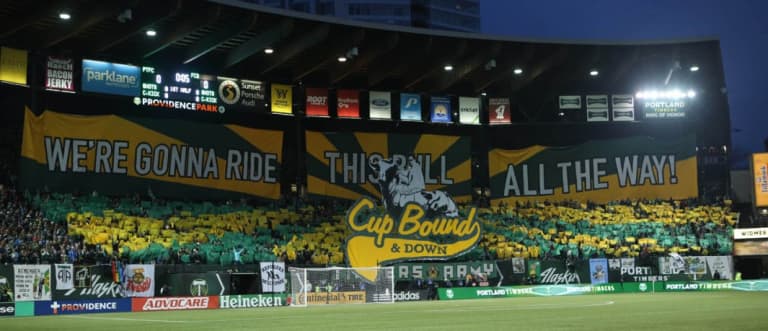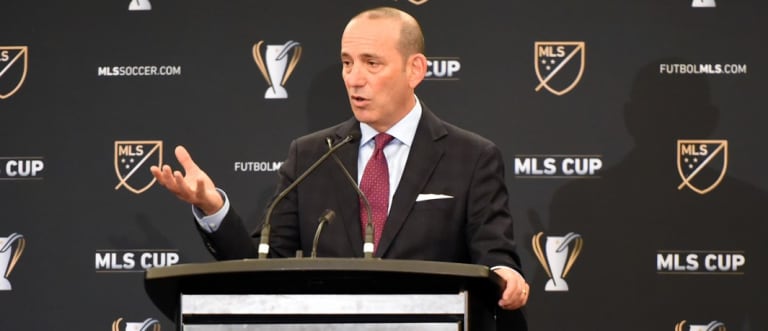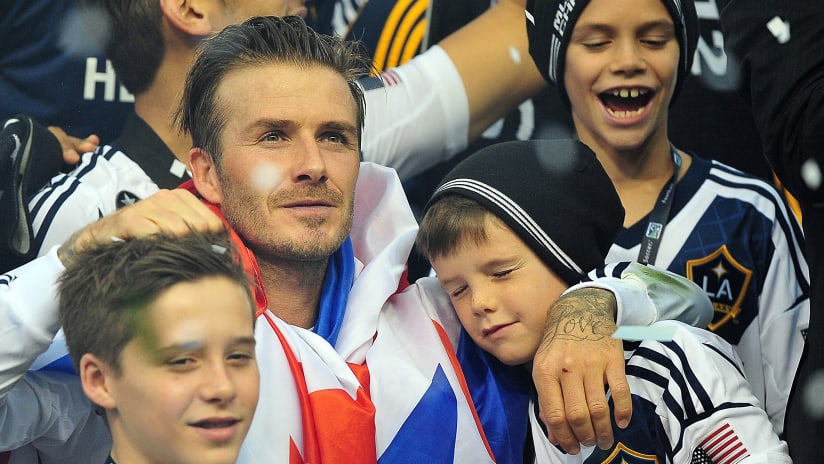A highly eventful decade is drawing to a close for Major League Soccer, one marked by stunning growth and evolution.
It’s been a long, winding and arduous road from the 1996 launch to the quarter-century celebrations that will unfold in 2020, with many milestones along the way – and the past 10 years have seen no less than a great leap forward of historical proportions.
Here’s my list of the seven biggest and most influential developments of the 2010s.
Cascadia climbs aboard

The Timbers Army's "Cup-bound & Down" tifo at Providence Park in 2015 | USA Today Sports Images
The Seattle Sounders’ influence on MLS since their epochal entrance in 2009 has gotten plenty of love in recent years, which is only right given their run of three MLS Cup trips in four years, and trophy hoists in two of them. But the fun really started with the full accession of their near-neighbors the Portland Timbers and Vancouver Whitecaps two years later.
The Pac Northwest’s passionate fans and deeply-rooted soccer cultures dialed up matchday atmospheres and showed what’s possible when the sport lives at the heart of North American communities.
Almost as important in the long run were the lessons gleaned about the power of history, proximity and identity in iconic rivalries like the Cascadia Cup, which took full flight in 2011 with all three competing teams back in the same league. It would help inform the league’s approach to matchups like El Trafico, New York’s Hudson River Derby, the Canadian Classique and the Hell Is Real Derby in Ohio.
Galaxy cap Beckham era with dynasty status
The 2012 MLS Cup final between the LA Galaxy and Houston Dynamo was a pulsating affair, a rematch of the previous season’s championship game and the first edition held at the home stadium of the finalist with the best regular-season record, instead of a predetermined site.
LA’s 3-1 comeback win at their home ground, back then the Home Depot Center but known today as Dignity Health Sports Park, also sealed their status as a true MLS dynasty. Yes, Bruce Arena’s Galaxy would truly punch that ticket two years later when they won their third title in four years. But the 2012 win was David Beckham’s swan song in MLS, and provided fateful validation of the Designated Player-driven model he epitomized.
Though younger audiences may struggle to comprehend it, the DP concept was still very much a work in progress at the start of the decade. Big names were clearly capable of goosing attendance and drawing buzz, yet several high-profile flops and the success of collectives like Real Salt Lake’s “the team is the star” group had raised doubts about their true value in competitive terms.
The Galaxy’s quality was driven by the DP trio of Beckham, Landon Donovan and Robbie Keane, and their devastating effectiveness at their peak showed the way forward for the rest of MLS. The idea of DPs as luxury trinkets soon drifted towards the margins as they become de rigeur tools for contenders.
Riding World Cup waves
Anyone wondering whether the fortunes of North American professional soccer and the continent’s national teams really are conjoined may want to consider the decade’s two biggest spikes in year-over-year MLS-wide attendance: 2011 and 2015.
It’s no accident that those are the seasons that followed FIFA World Cups – that’s been a recognizable pattern for most (though not all) of the league’s history. And the aforementioned tournaments were marked by strong, spirited performances by the US men’s national team, cheered on by millions of Americans both at home and on site in South Africa and Brazil, respectively.
Yes, this is one of many reasons why The Great Couva Disaster of 2017 was so costly to the sport on these shores – as are the Canadian national team’s ongoing struggles to climb back into Concacaf qualification contention.
A rising tide lifts all boats. And when an MLS star like Clint Dempsey or Landon Donovan – or even a future one like Jermaine Jones – shines on the world’s biggest stage, it provides a huge boost across the board. That’s why the upcoming 2022 qualifying cycle is so crucial, not to mention the potentially game-changing 2026 World Cup on home soil.
A new kind of DP: Sounders bring Deuce home
They dubbed it #DempseyWatch on social media.
A sudden, euphoric collective sleuthing effort, centered on several airports between London and Seattle on Aug. 1, 2014, it was fueled by rumors and reports that the USMNT’s biggest star and arguably the nation’s most successful-ever soccer export was coming home to MLS, specifically the Sounders.
It seemed like a long shot. Dempsey had made a big-money move from Fulham to Tottenham Hotspur just a year prior and was at the peak of his powers; no American in his situation had ever returned at quite such a juncture.
But eventually the reality took public shape: Seattle and MLS had quietly engineered a startling swoop for the star striker, laying out an unprecedented amount of money in the process. And setting a precedent that top domestic talent was worth investing in, too. Jozy Altidore, Michael Bradley and Tim Howard were just a few of those who would soon wear the DP tag as a result.
TAM, the acronym with afterburners

MLS Commissioner Don Garber | USA Today Sports Images
When MLS coined “Targeted Allocation Money” in the summer of 2015, some scoffed at what they thought was just another acronym in the league’s alphabet soup of jargon. But this new initiative would prove more influential than most.
Specifically intended to inject quality into the midsection of rosters and thus close the gap between DPs and the rank and file, TAM gave teams a major boost of spending power on the international market. Put simply, it made it easier to get better faster, and the overall level of play improved steadily. It was also accompanied by an effort to be more specific and transparent about the assets teams were swapping in trades and other transactions, an ongoing process that most fans welcomed.
Though it would turn out to bear some limitations of its own, TAM empowered MLS clubs to aim for players that were once out of reach, and helped the league’s reputation grow abroad.
ATL, TFC change the paradigm in 2017
MLS’s decision to award Atlanta an expansion franchise prompted widespread skepticism, with concerns about ATL’s viability as both a soccer town and sports market in general.
Atlanta United turned out to be an instant smash hit, drawing the league’s biggest crowds and fielding an exciting team packed with attacking verve, led by the distinguished Gerardo “Tata” Martino and based at one of the world’s most magnificent stadiums. The Five Stripes connected with a broad fanbase that reflected the city’s diversity and swagger… and gave leaders across the league a tantalizing vision of a whole new level to dream about.
“We Ready,” indeed.
The only thing that could steal the spotlight from ATLUTD in ‘17 was an achievement of historic proportions – and in a delicious twist of fate, it came from a club long regarded as a punchline, a byword for failure and futility.
It took nine years just for Toronto FC to book their first Audi MLS Cup Playoffs qualification, in 2015. But Altidore, Bradley, Sebastian Giovinco and the rest of that new-look TFC squad quickly relegated the dysfunctional old days to the memory bank, reaching MLS Cup a year later and finally scaling the mountaintop in 2017.
That was the crowning achievement of a “treble” campaign that also included the capture of the Canadian Championship and Supporters’ Shield trophies, something no MLS team had ever done – and it will take some doing for anyone to match it any time soon.
Bayern shell out $13.5-plus million for Fonzie
The first player born in the 2000s to play in an MLS match – and the youngest ever to score in Concacaf Champions League, Canadian Championship and United Soccer League play – would spark a watershed moment for the league.
Alphonso Davies’ personal story is truly incredible: Born in a refugee camp to Liberian parents escaping a bloody civil war, emigrated to distant Edmonton, Alberta as a child, spotted at a free soccer program for kids and guided through the Vancouver Whitecaps’ youth development system to a professional contract at the tender age of 15.
And the meteoric rise of “Fonzie” continued, as he swiftly became the Whitecaps’ most dangerous attacker and drew the attention of European heavyweights. When Bayern Munich won the race for his signature in July 2018, the German giants dropped an initial transfer fee north of $13 million with incentives and add-ons that could eventually run the deal to $22 mil.
It broke the league’s outgoing transfer record, validated the ambitious but costly academy system built to cultivate Homegrown Players and gave us all a glimpse of a dazzlingly bright potential future – one where American- and Canadian-reared talent could finally stand among the world’s best.
Now that’s a once-in-a-decade occasion.













